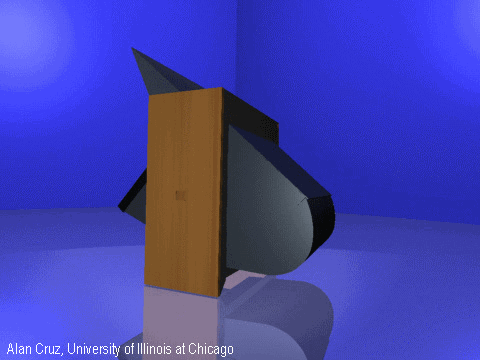ImmersaDesk™
January 1st, 1994 - December 1st, 1994
Categories: Commercialization, Devices, VR

About
The ImmersaDesk™ was developed in 1994 at EVL. It is a drafting table format VR display. It features a 67x50-inch rear-projected screen at a 45-degree angle. Up to 5 users wear shutter glasses to view high-resolution, stereoscopic, head tracked images.
The ImmersaDesk™ screen mostly fills a user’s field of view, and at the same time enables the user to look forward and down. One user’s head is tracked, allowing an accurate perspective to be generated.
A tracked wand is also used, so that the user can interact with the environment. The system is equipped with stereo sound supported by the Vanilla Sound Server (VSS) and Bergen. The ImmersaDesk™ cabinet is on wheels, and folds up and fits through doors. It can be deployed in offices, exhibition spaces, galleries or museums.
The ImmersaDesk™ is significantly smaller than the CAVE™, and it is also portable and self-contained. The projector is located in the lower section and a pop-up mirror folds the optics. The screen can rotate to the transportation position, where it is enclosed in the ImmersaDesk™ body, allowing the system to have a footprint of 34”Dx73”W.
Only one graphics pipe is needed for the ImmersaDesk™, which allows the use of a less expensive mid-range workstation. The decision to tilt the screen 45 degrees came from experience with the CAVE™. In the CAVE™, users usually look at images that are displayed on the walls. This might suggest that the CAVE™ floor is not important. However, if the floor is not used, a significant part of the VR experience is lost. This prompted us to design the ImmersaDesk™ to support looking down, as well as forward.
The ImmersaDesk™ user stands close to the screen, creating a 110 degree horizontal field of view. In that case, parts of the screen are viewed at large angles. In order for the entire image to appear uniformly bright, we chose a low gain screen. This screen is made of a clear plexiglass with sprayed on backcoating.
All parts of the ImmersaDesk™ cabinet are made of wood or stainless steel, so as to minimize interference with the electromagnetic tracking system. We use the low cost Ascension Technologies’ SpacePad system, though other tracking device solutions are being explored.
The ImmersaDesk™ uses the same CAVE™ library software as is used in the CAVE™, to generate accurate perspective projection, and to read tracker and input devices. Therefore, applications developed for the CAVE™ can be run on the ImmersaDesk™, and vice versa, without any code changes.
The ImmersaDesk™ system is commercially available through FakeSpace Systems Inc. The CAVE™ library software is available through VRCO.